Read by Melly Sutton
I’ve lived to a good age. That’s according to Sally, my home-help (lovely lass, pink hair, large tawny owl tattoo on her neck). Considering I’m a grumpy old whatshisname, she’s got the… what do they call it nowadays? knack? when it comes to chivvying me along. I’ve lived too long.
Another regret? I wish I could hear. Sally writes stuff down or mouths words, we manage, but I miss not hearing. The birds mostly. I miss hearing the birds.
This morning Sally’s acting like a demented fairy, skipping round me in her hobnail boots. She’s attached something to my wrist and is mouthing ‘feel’ and ‘birds,’ whilst madly flapping her arms. Daft apeth!
These days we only walk in the garden, since the falling incident when that whippersnapper of a van driver helped me home. It was an uneven curb, not even my fault. I told everyone that at the time.
Sally has guided me outside, and this watch-thing has started vibrating as we walk towards the shed. The vibrations keep changing. One, two, three, four. A pause, then four more slightly longer. We walk along the herbaceous border. Here, there’s one continuous vibration that pulses right through my bones.
“A wren?” I whisper. She nods, grinning. “Before that?” I wrack my brain, “a song thrush?” Another nod.
I’m stunned, I can’t take my eyes off this gadget that’s helping me hear the birds for the first time in years. I glance over at Sally.
“Happy Birthday,” she mouths.



One thought on “The Gift by Jane V. Adams”